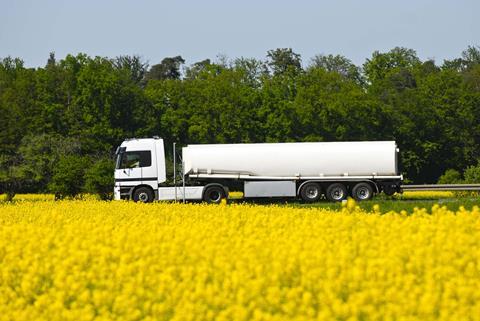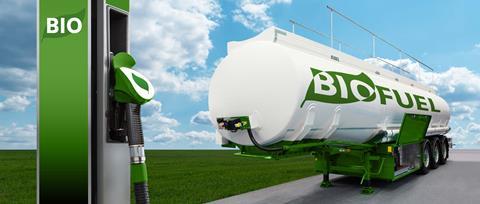What is the technology?
Drop-in fuels can be used as direct replacements for diesel in a conventional vehicle with a compression engine. Because of their ‘drop-in’ nature, they can be deployed to significantly reduce CO2 emissions in transport operations quickly and effectively with no or minimal impact on the operation of a fleet.
Drop-in fuels are hydrocarbons (just like diesel) in that they are a compound of hydrogen and carbon. Traditional or fossil diesel is refined from crude oil, whereas drop-in fuels are derived from organic oils. Organic oils can come from used cooking oil and other waste streams or it can come from virgin crops.
While there are four main types of fuel that could be considered drop-in fuels – HVO, biodiesel (FAME), e-fuels and GTL – the two that are most relevant and offer a decarbonisation pathway for running commercial vehicles are HVO and biodiesel - both organic oil derived fuels.

Both HVO and biodiesel are created from waste organic oils but the process for making each is quite different. HVO is hydrotreated vegetable oil and the end product is very stable and long lasting in storage. It is compatible with diesel engines up to Euro 6.
Biodiesel is created through a process called esterification and is technically known as fatty acid methyl ester (FAME). Biodiesel is generally compatible with diesel engines without EGR or SCR aftertreatment systems – compatibility with the latest Euro 6 engines can be limited to blends. Forecourt fossil diesel today contains 7% FAME as part of the Renewable Transport Fuels Obligation scheme. Higher blends may be compatible and 100% can work with certain engines with or without some modifications to filtration systems and service intervals.
Environmental Considerations
The obvious question is why are drop-in fuels considered a solution to CO2 emissions whereas diesel is a problem? Both fuels emit similar amounts of CO2 into the atmosphere, however, the CO2 emitted from diesel comes from the carbon atoms in the source crude oil which has been extracted from the earth and released into the atmosphere. The CO2 generated when combusting drop-in fuels comes from the carbon in the plants grown to produce the vegetable oil; this carbon is extracted from the atmosphere during the plants growth and therefore no additional carbon is added to the atmosphere. In simple terms, it can only ever emit what it drew down from the atmosphere in the first place - this is known as a ‘short carbon cycle’.
Because of this short CO2 cycle, only the additional CO2 generated in the production and distribution of the fuel needs to be counted. This gives drop-in fuels a CO2 saving potential of around 90% compared with diesel. Drop-in fuels can be used in trucks, generators, plant and machinery.
Cost
HVO
On the plus side, HVO is a great ‘today’ solution for many applications from an operational perspective. On the downside, HVO is more expensive than diesel, by 15%-20% depending on volume. If you are a haulier selling transport services this additional cost must be passed on to end customers in full which can reduce the competitiveness or the profitability of a business.
If a transport operator can sell the CO2 benefit that’s great, but if not, it can be problematic. For own account operators the additional cost of HVO affects only the distribution element of their end product and in this scenario can be much simpler to account for.
Biodiesel (FAME)
Again, this is a ‘ready to go’ solution for many applications and the benefit of FAME over HVO is that it is cheaper to produce and does not have the same additional cost implications. This advantage may be somewhat offset by additional service costs depending on the engine in question. Some engines may work with 100% FAME but the OEMs need to test and certify each engine type and this work is not always a high priority for manufacturers. For this reason, FAME is often used with out of warranty equipment or equipment that is serviced in-house.
There is some discussion over the fuel duty levied on carbon reducing drop-in fuels which is currently the same as diesel. The possibility of a fuel duty discount is on the table which would remove some cost barriers to drop-in fuels, however, there is no agreement or guarantee it will happen, but it’s one to watch.
Availability
Currently in the UK there are very few forecourts that sell drop-in fuels, so on-site bunkering is normally the only option. For some, this is not a problem as they already bunker diesel and the same tank can be used. The costs for on-site bunkering can often be offset by the reduction in distances and journey times no longer required to refuel on the road.
One thing that needs highlighting with HVO is that it is important to work with a reputable provider to establish the providence of the feedstock. Because used cooking oil was formerly viewed as a waste product and now has a value to HVO producers, it is important to ensure that the used cooking oil is genuinely a waste product and not a palm oil derived product.
Palm oil is grown in deforested areas and expanding the market for palm oil promotes deforestation. In some parts of the world, used cooking oil is used for animal feed – if the value of that cooking oil increases there is a risk that the oil is sold and is substituted with palm oil to feed animals. In the UK, we have a strict certification scheme to ensure that HVO is a genuine waste product so there shouldn’t be any need for concern provided you work with a certified supplier.
Operational implications
HVO - referring back to my matrix, I have indicated fuel cost, infrastructure and tailpipe emissions as the downsides to HVO. For a long haul operation that already bunkers fuel and can accommodate the small additional cost in their finances or cover with efficiency gains, HVO represents a really positive step towards decarbonisation. The tailpipe emissions for HVO are often better than diesel but as they are not zero the forthcoming ICE (internal combustion engine) bans will impact the HVO market for transport.
FAME has a cost benefit over HVO, the downside is less wide compatibility with newer engines and longer term storage can be an issue as the fuel can take on water if conditions are not optimal. Closer attention needs to be paid to storage tanks and their maintenance regimes. Some engines may need slight modification to gaskets and filters and may have reduced service intervals.

Blending with fossil diesel is an option for both HVO and FAME; blending can improve compatibility and offers a progressive path to decarbonisation in some instances. However, with HVO, blending is less common as there is less need due to the wider compatibility with engines; for FAME, blending is much more common as it is already blended with fossil diesel so the infrastructure exists and some engines have a % blend compatibility.
Summary
If we stopped using diesel and just used HVO instead, would that be good enough to meet our CO2 targets? Theoretically it would get us very close, however, there is not enough used cooking oil or other waste streams to produce anywhere near enough fuel to fully replace diesel. Again, theoretically we could grow crops to produce virgin oils to replace diesel but then we stumble into another problem - Land Use Efficiency. We would be taking land used for food production for fuel production which is much less sustainable.
Overall, drop-in fuels do offer an immediate impact on CO2 emissions. They can also be deployed with little investment and can work well in sectors where other options are limited. However, they don’t solve air quality issues and are due to be phased out with ICE bans. Although, these bans are still a few replacement cycles away and reducing CO2 in the atmosphere today, reduces the task that future technologies will have to contend with.
To summarise, there is enough potential for waste derived drop-in fuels to use today while waiting for better alternatives and, legislation aside, enough to use in the most difficult to decarbonise sectors where electric based technologies may take longer to mature e.g. STGO or mobile plant.











